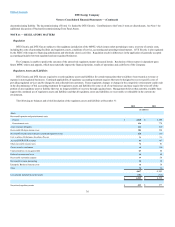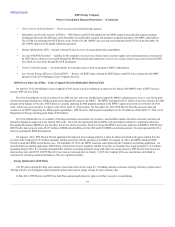DTE Energy 2012 Annual Report Download - page 71
Download and view the complete annual report
Please find page 71 of the 2012 DTE Energy annual report below. You can navigate through the pages in the report by either clicking on the pages listed below, or by using the keyword search tool below to find specific information within the annual report.
Table of Contents
fluctuations of the Canadian dollar relative to the U.S. dollar. These derivatives are accounted for by recording changes in fair value to earnings unless hedge
accounting criteria are met.
Corporate and Other — Interest Rate Risk — The Company uses interest rate swaps, treasury locks and other derivatives to hedge the risk associated
with interest rate market volatility. In 2004 and 2000, the Company entered into a series of interest rate derivatives to limit its sensitivity to market interest rate
risk associated with the issuance of long-term debt. Such instruments were designated as cash flow hedges. The Company subsequently issued long-term debt
and terminated these hedges at a cost that is included in Other comprehensive loss. Amounts recorded in Other comprehensive loss will be reclassified to
interest expense through 2033. In 2013, the Company estimates reclassifying less than $ 1 million of losses to earnings.
Credit Risk — The utility and non-utility businesses are exposed to credit risk if customers or counterparties do not comply with their contractual
obligations. The Company maintains credit policies that significantly minimize overall credit risk. These policies include an evaluation of potential customers’
and counterparties’ financial condition, credit rating, collateral requirements or other credit enhancements such as letters of credit or guarantees. The Company
generally uses standardized agreements that allow the netting of positive and negative transactions associated with a single counterparty. The Company
maintains a provision for credit losses based on factors surrounding the credit risk of its customers, historical trends, and other information. Based on the
Company’s credit policies and its December 31, 2012 and 2011 provision for credit losses, the Company’s exposure to counterparty nonperformance is not
expected to have a material adverse effect on the Company’s financial statements.
Derivative Activities
The Company manages its mark-to-market (MTM) risk on a portfolio basis based upon the delivery period of its contracts and the individual
components of the risks within each contract. Accordingly, it records and manages the energy purchase and sale obligations under its contracts in separate
components based on the commodity (e.g. electricity or gas), the product (e.g. electricity for delivery during peak or off-peak hours), the delivery location (e.g.
by region), the risk profile (e.g. forward or option), and the delivery period (e.g. by month and year). The following describe the four categories of activities
represented by their operating characteristics and key risks:
•Asset Optimization — Represents derivative activity associated with assets owned and contracted by DTE Energy, including forward gas
purchases and sales, gas transportation and storage capacity. Changes in the value of derivatives in this category typically economically offset
changes in the value of underlying non-derivative positions, which do not qualify for fair value accounting. The difference in accounting treatment
of derivatives in this category and the underlying non-derivative positions can result in significant earnings volatility.
•Marketing and Origination — Represents derivative activity transacted by originating substantially hedged positions with wholesale energy
marketers, producers, end users, utilities, retail aggregators and alternative energy suppliers.
•Fundamentals Based Trading — Represents derivative activity transacted with the intent of taking a view, capturing market price changes, or
putting capital at risk. This activity is speculative in nature as opposed to hedging an existing exposure.
•Other — Includes derivative activity at DTE Electric related to FTRs. Changes in the value of derivative contracts at DTE Electric are recorded as
Derivative Assets or Liabilities, with an offset to Regulatory Assets or Liabilities as the settlement value of these contracts will be included in the
PSCR mechanism when realized.
69
























